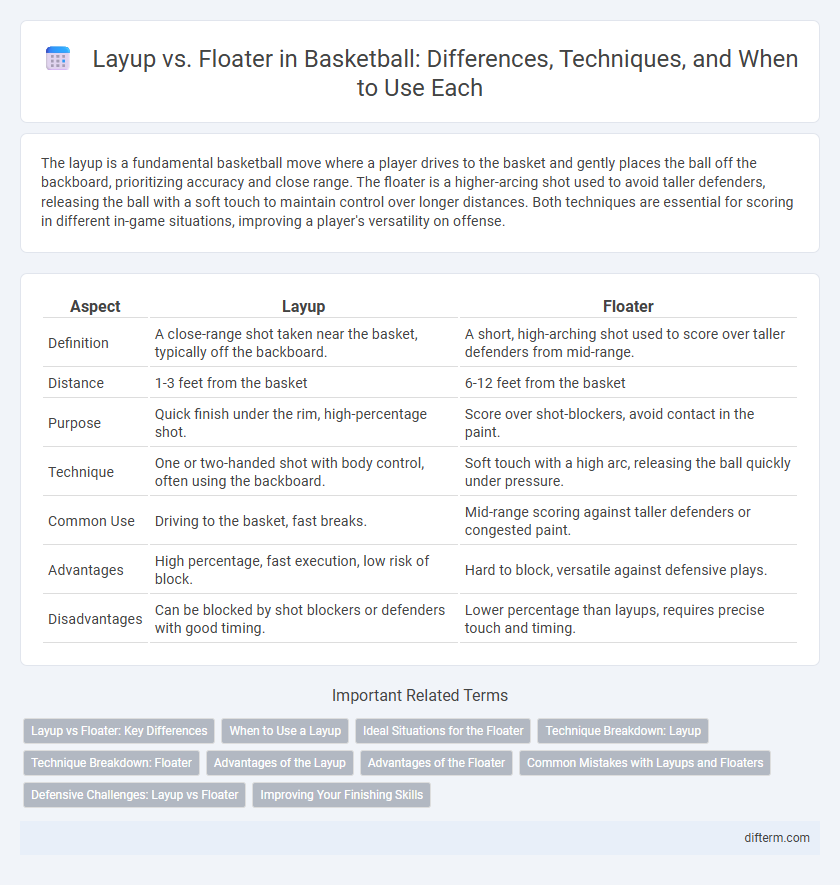The layup is a fundamental basketball move where a player drives to the basket and gently places the ball off the backboard, prioritizing accuracy and close range. The floater is a higher-arcing shot used to avoid taller defenders, releasing the ball with a soft touch to maintain control over longer distances. Both techniques are essential for scoring in different in-game situations, improving a player's versatility on offense.
Table of Comparison
| Aspect | Layup | Floater |
|---|---|---|
| Definition | A close-range shot taken near the basket, typically off the backboard. | A short, high-arching shot used to score over taller defenders from mid-range. |
| Distance | 1-3 feet from the basket | 6-12 feet from the basket |
| Purpose | Quick finish under the rim, high-percentage shot. | Score over shot-blockers, avoid contact in the paint. |
| Technique | One or two-handed shot with body control, often using the backboard. | Soft touch with a high arc, releasing the ball quickly under pressure. |
| Common Use | Driving to the basket, fast breaks. | Mid-range scoring against taller defenders or congested paint. |
| Advantages | High percentage, fast execution, low risk of block. | Hard to block, versatile against defensive plays. |
| Disadvantages | Can be blocked by shot blockers or defenders with good timing. | Lower percentage than layups, requires precise touch and timing. |
Layup vs Floater: Key Differences
The layup is a close-range basketball shot performed by driving to the basket and releasing the ball with one hand off the backboard, offering high accuracy and quick execution. The floater, executed with a softer touch and higher arc, is ideal for shooting over taller defenders from mid-range distances. Understanding the key differences between layups and floaters enhances scoring versatility and decision-making in fast-paced game situations.
When to Use a Layup
Use a layup when approaching the basket with a clear lane and minimal defensive pressure, allowing for a high-percentage shot close to the hoop. Layups excel in fast-break situations and when driving past defenders who are out of position. This shot offers greater accuracy and control compared to floaters, making it ideal for scoring in traffic with a direct path to the rim.
Ideal Situations for the Floater
The floater excels in situations where defenders crowd the paint, allowing shooters to release the ball early and avoid shot-blockers. It is ideal in fast breaks or when approaching taller opponents, providing a high-arc shot that clears defenders. Players use floaters extensively in pick-and-roll scenarios or when driving against aggressive shot contests.
Technique Breakdown: Layup
A layup involves driving toward the basket and releasing the ball off the backboard with one hand, emphasizing body control and precision. Proper footwork includes a two-step approach where the player takes off on the opposite foot from their shooting hand, maximizing leverage and balance. Mastering hand placement and using the backboard's sweet spot ensures higher success rates in close-range scoring opportunities.
Technique Breakdown: Floater
The floater in basketball requires a delicate touch and precise wrist flick to loft the ball over taller defenders while maintaining control and accuracy. Key technique elements include releasing the ball higher than a typical layup, using the fingertips to guide the ball, and incorporating a quick, fluid motion to avoid shot blockers. Mastery of the floater demands strong body control, footwork to create space, and the ability to read defenders for optimal shot timing.
Advantages of the Layup
The layup offers a high-percentage shot opportunity due to its close proximity to the basket, increasing scoring efficiency in fast-break situations. This technique allows players to use the backboard for better accuracy and control, minimizing the chances of missed attempts. It also provides a quicker release compared to floaters, making it harder for defenders to block the shot.
Advantages of the Floater
The floater offers greater versatility in scoring over taller defenders by allowing players to release the ball quickly and with a high arc, reducing the chance of blocks. Its controlled touch and timing make it ideal for navigating through traffic in the lane, enhancing scoring efficiency in congested areas. The floater's adaptability to different angles and speeds provides players with a reliable scoring option when a traditional layup is contested.
Common Mistakes with Layups and Floaters
Common mistakes with layups include poor footwork, leading to loss of balance and missed shots, and improper use of the backboard, reducing scoring efficiency. Floaters often suffer from incorrect release timing and inadequate arc, causing the ball to either fall short or hit the rim harshly. Mastering body control and shot mechanics significantly improves success rates for both layups and floaters in basketball.
Defensive Challenges: Layup vs Floater
The layup faces significant defensive challenges due to its proximity to the rim, allowing defenders to contest shots aggressively with blocks or charges. In contrast, the floater, released with a higher arc from mid-range, creates difficulties for defenders by minimizing shot blocking opportunities and exploiting taller defenders' timing. This strategic difference forces defenses to adjust positioning and anticipation, impacting overall defensive effectiveness.
Improving Your Finishing Skills
Mastering the layup enhances your close-range scoring by emphasizing precision, footwork, and timing around the rim. The floater complements this skill set by offering a versatile mid-range shot to evade taller defenders and control the arc over opponents' outstretched hands. Improving finishing skills involves repetitive drills that develop hand-eye coordination, body control, and shot selection under pressure.
layup vs floater Infographic

 difterm.com
difterm.com